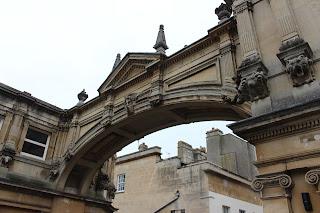I went to one of my favourite cities today. Turns out the city of Bath, England was granted
World Heritage status by UNESCO in 1987 which identifies it as “a masterpiece
of human creative genius whose protection must be the concern of all.“
Much of the heart of Bath is built from Bath limestone
during the Georgian period – which is a very elegant stone, especially in the
sunlight. Didn’t get any of those golden
hues today though as the fairly constant rain gave me a very good reason to
linger indoors – be it at the Bath Abbey, the Roman Baths or the pub.
Here’s an outdoor photo of the plaza in front of the abbey. You can see the limestone buildings as well
as the crowds. The plaza is the start of
most walking tours and groups visiting the baths to the left of the abbey.
The abbey has amazing architecture – I don’t know the
correct terminology, but I can certainly appreciate its beauty. Here’s a picture facing the front. The stained glass is actually over 50
different depictions from the bible.
Here’s a close up of the ceiling.
On all the walls and alcoves were stained glass
windows. Here’s one of King Arthur and St.
George. Didn’t think the biblical
figures and Arthurian legends could co-exist in a place of worship.
I learned to play the organ as a child so I am always drawn
to pipe organs in churches. This one is
splendid and has angel musicians playing below it.
I was amused to see one of the angels playing the
bagpipes. Who knew, eh?
Meandering slowly around the building there were a plethora
of wall and floor tablets to read. Most
were from the 1700s and 1800s. One of my
favourites was this one for Anne who died on August 19, 1733:
Sacred to the dear
memory of Anne, only daughter of George Finch, Esq. of Valentines in Essex. An
excellent person, well natured, discreet and virtuous, most affectionately
beloved by her relations & most justly esteemed by all who knew her.
It pleased God to
visit her with a tedious and severe illness, which, (tho in the flower of her
age & blessed with a plentiful fortune) she bore with great evenness and
constancy.
She prepared herself
by frequent and fervent devotion for her dissolution which she waited for with
such pious resignation as manifested her heart to be affected with the power of
religion and the well grounded hopes of a beloved eternity.
Her being the more
desirable in that the first real occasion of grief she gave her sorrowful
mother was her death.
After reading my fill, I joined the queue of people waiting
to see the Roman Baths. I’ve never
actually visited the Roman Baths on my previous visit so decided I was
overdue. Here’s the entrance with its
elegant limestone and signs.
I didn’t know what to expect as all I ever saw on postcards
and advertising was the main bath. Was that all there was? Apparently not. The area was built by the Romans and named it
Aquae Sulis. In addition to many baths
of varying temperatures there was also a temple dedicated to Sulis Minerva.
Wasn’t Minerva with the head of snakes?
These baths are “the finest Roman spa north of the Alps, still flowing
with natural hot water, the only hot springs in the UK.” There are only two pools that are full now
most everything else is in ruins and the museum shows artifacts and talks about
how the baths worked and the social culture around them.
Because it was a cold and rainy day one could see the steam
coming off the 35 degree Celcius water.
The water is tinged green as the pool no longer has a roof like it did
in Roman times so the sunlight has caused algae to grow.
Above this largest pool was a terrace and Roman historical
figures will built on top in the last couple of centuries. The terrace was a great place for me to get a
different viewpoint of the abbey and also of an archway between the adjacent
buildings.
On the lower level, I was better able to get the steam in my
photos and even managed to get a photo without any tourists in it.
Here’s a smaller, hotter pool which I took through a gap in
the walls (Cheryl, I can hear your muttering about holes from here!).
Before heading to the train station I stopped at a pub for a
pint of Thatcher’s cider and a lunch of fish and chips (and peas – not mushy
ones thankfully).
Have now arrived in Southall, London. As I’m staying in an Indian neighbourhood I
think I’ll grab a curry from the restaurant on the ground floor of my small,
family-run hotel. Need to get to bed
early tonight as I’ve got a 9 hour flight tomorrow during the day and another
time change – three hours I think.




















3 comments:
Cheryl here...
Minerva is the Roman version of Athena. The architecture of the Abbey is breathtaking.
Cheryl, what was she the god of?
Cheryl here...
Silos Minerva was a combining of the original Celtic goddess of Bath, Sulis, with Minerva.
Sulis was goddess of the sun, spring water and hot springs.
Minerva was the Roman goddess of wisdom, reason, purity and protection of home and state.
Yes, I had to look it up.
Post a Comment